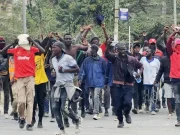By Adjei Richard Adjetey (UniMAC-IJ, Email: radjeteyadjei4@gmail.com)
According to the United Nations International Children’s Emergency Fund (UNICEF), a total of 154 million children, 64 million girls, and 88 million boys are estimated to be in child labor globally, accounting for almost one in ten of all children worldwide.
In Ghana, most fishing communities have seen numerous male children of school-going age sacrificing their books for baits to survive and to support families, and Awudum, one such community located in Tema New-Town is no exception.
In Awudum, this has taken the form of fishermen luring juveniles with money in exchange for cheap labor on high tides because most members of the fishing community are poor.
Adolescent boys in places like these are exposed to exploitation due to ignorance of their rights and inability, to make informed decisions. They are prone to child labour as they fend for themselves and their families.
Away from the fact that some juveniles willingly do this as a means of survival, there are situations where their parents coerce them into it after bargaining with fishermen at their ward’s blind sight. They do this as a coping strategy to solve economic challenges and the survival of their families.
This exploitation is a result of poverty, areas with poverty, and food insecurity, and where there exists the traditional belief that male children are born to care for the family, there is a risk of using male children for labour in exchange for money (Ortiz-Ospina & Roser,2016). In such a situation, there is an urgent need for interventions to safeguard vulnerable boy children.
A 12-year-old Atta Kwesi, not his real name, was forced into fishing because his parents could not pay his school fees. He was caught in the web of a fisherman who exploited him by sending him underwater to check the tangled net, which left him with deep facial scars.
“I never expected to be hurt in the work I got myself into. I wanted to attend school, but my parents could not settle my fees, and I had to balance this work to care for my education. I feel ashamed to step out with my scars” he said.
In Ghana’s 1997 ratified Children’s Act by Parliament, “the minimum age for children to be involved in light work is 13 years old, and to be involved in hazardous work is 18” per the law, anything to do with a child beneath the age bracket is a crime. However, the perpetrators of this act are not sanctioned. This hinders the achievement of Sustainable Development Goals 7 and, 8 which call for effective measures to eradicate forced labour, trafficking, and the worst form of child labour.
Mrs. Agnes Amissah, a concerned community member said, such acts should never be motivated, no matter the poverty rate of the family.
“Most of the boys are not aware they have not attained the age to work. Different factors contribute to exploiting them but if we limit it to poverty, it will be hard to find solutions to poverty without taking a closer look at other socio-economic causes. There is ignorance on the side of parents who are unaware of what their children are subjected to”
Amidst the dilemma, the International Labour Organization at its World Day Against Child Labour 2024 themed Let’s Act on our commitments: End Child Labour, has put actions in place such as calling upon stakeholders, including governments, organizations, businesses, and individuals to join hands to end child labour in all forms.






































